Yamaha Audio MU100R User Manual
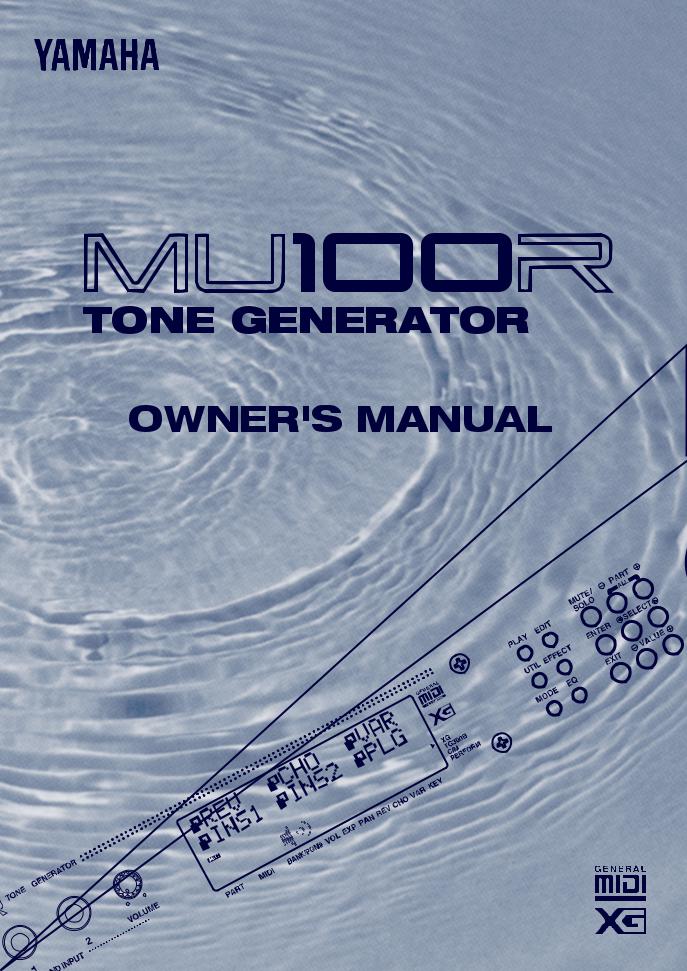
Downloaded from: http://www.usersmanualguide.com/

FCC INFORMATION (U.S.A)
1.IMPORTANT NOTICE : DO NOT MODIFY THIS UNIT!
This product, when installed as indicated in the instructions contained in this manual, meets FCC requirements. Modifications not expressly approved by Yamaha may void your authority, granted by the FCC, to use the product.
2.IMPORTANT: When connecting this product to accessories and/or another product use only high quality shielded cables. Cable/s supplied with this product MUST be used. Follow all installation instructions. Failure to follow instructions could void your FCC authorization to use this product in the USA.
3.NOTE: This product has been tested and found to comply with the requirements listed in FCC Regulations, Part 15 for Class “B” digital devices. Compliance with these requirements provides a reasonable level of assurance that your use of this product in a residential environment will not result in harmful interference with other electronic devices. This equipment generates/uses radio frequencies and, if not installed and used according to the instructions found in the user’s manual, may cause interference harmful to the operation of other electronic devices. Compliance with FCC regulations does not guarantee that interference will not occur in all installations. If this product is found to be the source of interference, which can be determined by turning the unit “OFF” and “ON”, please try to eliminate the problem by using one of the following measures:
Relocate either this product or the device that is being affected by the interference.
Utilize power outlets that are on different branch (circuit breaker or fuse) circuits or install AC line filter/s.
In the case of radio or TV interference, relocate/reorient the antenna. If the antenna lead-in is 300 ohm ribbon lead, change the lead-in to co-axial type cable.
If these corrective measures do not produce satisfactory results, please contact the your local retailer authorized to distribute this type of product. If you can not locate the appropriate retailer, please contact Yamaha Corporation of America, Electronic Service Division, 6600 Orangethorpe Ave, Buena Park, CA 90620
*The above statements apply ONLY to those products distributed by Yamaha Corporation of America or its subsidiaries.
NEDERLAND / NETHERLAND
•Dit apparaat bevat een lithium batterij voor geheugen back-up.
•This apparatus contains a lithium battery for memory back-up.
•Raadpleeg uw leverancier over de verwijdering van de batterij op het moment dat u het apparaat ann het einde van de levensduur afdankt of de volgende Yamaha Service Afdeiing:
Yamaha Music Nederland Service Afdeiing Kanaalweg 18-G, 3526 KL UTRECHT
Tel. 030-2828425
•For the removal of the battery at the moment of the disposal at the end of the service life please consult your retailer or Yamaha
Service Center as follows:
Yamaha Music Nederland Service Center Address : Kanaalweg 18-G, 3526 KL UTRECHT
Tel |
: 030-2828425 |
•Gooi de batterij niet weg, maar lever hem in als KCA.
•Do not throw away the battery. Instead, hand it in as small chemical waste.
ADVARSEL!
Lithiumbatteri—Eksplosionsfare ved fejlagtig håndtering. Udskiftning må kun ske med batteri af samme fabrikat og type. Levér det brugte batteri tilbage til leverandoren.
VARNING
Explosionsfara vid felaktigt batteribyte. Använd samma batterityp eller en ekvivalent typ som rekommenderas av apparattillverkaren. Kassera använt batteri enligt fabrikantens instruktion.
VAROITUS
Paristo voi räjähtää, jos se on virheellisesti asennettu. Vaihda paristo ainoastaan laitevalmistajan suosittelemaan tyyppiin. Hävitä käytetty paristo valmistajan ohjeiden mukaisesti.
92-BP
Downloaded from: http://www.usersmanualguide.com/

SPECIAL MESSAGE SECTION
This product utilizes batteries or an external power supply (adapter). DO NOT connect this product to any power supply or adapter other than one described in the manual, on the name plate, or specifically recommended by Yamaha.
WARNING: Do not place this product in a position where anyone could walk on, trip over, or roll anything over power or connecting cords of any kind. The use of an extension cord is not recommended! If you must use an extension cord, the minimum wire size for a 25' cord (or less ) is 18 AWG. NOTE: The smaller the AWG number, the larger the current handling capacity. For longer extension cords, consult a local electrician.
This Product should be used only with the components supplied or; a cart, rack, or stand that is recommended by Yamaha. If a cart, etc., is used, please observe all safety markings and instructions that accompany the accessory product.
SPECIFICATIONS SUBJECT TO CHANGE: The information contained in this manual is believed to be correct at the time of printing. However, Yamaha reserves the right to change or modify any of the specifications without notice or obligation to update existing units.
This product, either alone or in combination with an amplifier and headphones or speaker/s, may be capable of producing sound levels that could cause permanent hearing loss. DO NOT operate for long periods of time at a high volume level or at a level that is uncomfortable. If you experience any hearing loss or ringing in the ears, you should consult an audiologist. IMPORTANT: The louder the sound, the shorter the time period before damage occurs.
Some Yamaha products may have benches and/or accessory mounting fixtures that are either supplied with the product or as optional accessories. Some of these items are designed to be dealer assembled or installed. Please make sure that benches are stable and any optional fixtures (where applicable) are well secured BEFORE using. Benches supplied by Yamaha are designed for seating only. No other uses are recommended.
NOTICE: Service charges incurred due to lack of knowledge relating to how a function or effect works (when the unit is operating as designed) are not covered by the manufacturer’s warranty, and are therefore the owners responsibility. Please study this manual carefully and consult your dealer before requesting service.
ENVIRONMENTAL ISSUES: Yamaha strives to produce products that are both user safe and environmentally
friendly. We sincerely believe that our products and the production methods used to produce them, meet these goals. In keeping with both the letter and the spirit of the law, we want you to be aware of the following:
Battery Notice: This product MAY contain a small nonrechargeable battery which (if applicable) is soldered in place. The average life span of this type of battery is approximately five years. When replacement becomes necessary, contact a qualified service representative to perform the replacement.
This Product may also use “household” type batteries. Some of these may be rechargeable. Make sure that the battery being charged is a rechargeable type and that the charger is intended for the battery being charged.
When installing batteries, do not mix old batteries with new, or with batteries of a different type. Batteries MUST be installed correctly. Mismatches or incorrect installation may result in overheating and battery case rupture.
Warning: Do not attempt to disassemble, or incinerate any battery. Keep all batteries away from children. Dispose of used batteries promptly and as regulated by the laws in your area.
Note: Check with any retailer of household type batteries in your area for battery disposal information.
Disposal Notice: Should this Product become damaged beyond repair, or for some reason its useful life is considered to be at an end, please observe all local, state, and federal regulations that relate to the disposal of products that contain lead, batteries, plastics, etc. If your dealer is unable to assist you, Please contact Yamaha directly.
NAME PLATE LOCATION: The name Plate is located on the top of the product. The model number, power requirements, etc., are located on this plate. (The serial number is located on the rear panel.) You should record the model number, serial number, and the date of purchase in the spaces provided below and retain this manual as a permanent record of your purchase.
POWER
ON/  OFF
OFF
Model
Serial No.
Purchase Date
PLEASE KEEP THIS MANUAL
Downloaded from: http://www.usersmanualguide.com/

Welcome to the M U 100R
Welcome to the MU100R
Congratulations and thank you for purchasing the Yamaha MU100R Tone Generator!
The MU100R is an advanced tone generator providing an amazing total of
1523 high-quality Voices, full General MIDI compatibility — including Yamaha’s new XG-MIDI (Extended General MIDI) — plus flexible computer interfacing in a compact, easy-to-use rack mount unit.
Included in the 1523 Voices are 256 extraordinarily realistic and expressive VL Voices — provided by a separate, yet integrated Virtual Acoustic Synthesis tone generator.
With the convenient built-in host computer interface and MIDI terminals, the MU100R is ideal for any computer music system — from connection to a simple laptop to integration in a complete MIDI studio. With its large LCD and the intuitive graphic controls on the display, the MU100R is remarkably easy to use.
The MU100R also features completely independent dual MIDI inputs, 32 Part multi-timbral capacity and full 64-note polyphony for playback of even the most sophisticated song data. A special Performance mode gives you flexible four-Voice operation, for live performance applications. Also built into the system are six digital multi-effects and two EQ sections (one per-part, and one overall), which give you enormous versatility in “sweetening” the sound. What’s more, the MU100R provides a host of comprehensive, yet easy-to-use editing tools for getting just the sound you need.
The MU100R also has convenient A/D inputs that allow you to connect a microphone, electric guitar or other instrument, and mix those signals with the MU100R’s Voices. A separate Hamony effect section lets you automatically apply two-, threeor four-part harmonies to your A/D input vocals, and have them change as you play different chords on a connected MIDI keyboard.
*Company names and product names in this Owner’s Manual are the trademarks or registered trademarks of their respective companies and are hereby acknowledged.
ii
Downloaded from: http://www.usersmanualguide.com/

U npacking
Unpacking
Your MU100R package should include the items listed below. Make sure that you have them all. Also, write down the serial number of your MU100R in the box below, for future reference.
MU100R |
Serial No.: |
|
|
PA-5B AC Power Adaptor
Owner’s Manual
Floppy Disk
iii
Downloaded from: http://www.usersmanualguide.com/

TABLE O F CO N TEN TS |
|
Table of Contents |
|
Welcome to the MU100R ....................................................................................................... |
ii |
Unpacking .............................................................................................................................. |
iii |
Table of Contents .................................................................................................................. |
iv |
How to Use This Manual .................................................................................................... |
viii |
PRECAUTIONS .................................................................................................................... |
ix |
The Controls of the MU100R ................................................................................................ |
1 |
Front Panel .................................................................................................................... |
1 |
Rear Panel ..................................................................................................................... |
3 |
The MU100R — What It Is and What It Can Do ............................................................... |
4 |
What It Is... ....................................................................................................................... |
4 |
About General MIDI .................................................................................................... |
4 |
About XG-MIDI ........................................................................................................... |
5 |
What It Can Do... ............................................................................................................. |
5 |
Using With MIDI Keyboard ......................................................................................... |
5 |
Using With a Computer or Sequencer .......................................................................... |
5 |
About the Modes of the MU100R ................................................................................... |
6 |
Play Modes and the Part Controls ................................................................................ |
7 |
Part Edit Mode .............................................................................................................. |
7 |
Utility Mode ................................................................................................................. |
7 |
Modes and Function Tree ...................................................................................................... |
8 |
GU ID ED TO U R |
|
Setting Up Your MU100R .............................................................................................. |
12 |
What You'll Need ........................................................................................................ |
12 |
Making the Connections ............................................................................................. |
12 |
Powering Up .................................................................................................................... |
14 |
Playing the Demo Song .................................................................................................. |
15 |
Setting Up the MU100R in Your Music System .......................................................... |
17 |
Connecting to MIDI Devices ..................................................................................... |
17 |
Connecting Directly to a Computer ........................................................................... |
19 |
Macintosh and Compatibles ................................................................................. |
19 |
IBM PC/AT and Compatibles ............................................................................... |
21 |
Selecting and Playing the Performances ...................................................................... |
23 |
Calling Up the Performance Play Mode and Playing the Performances ................... |
23 |
Selecting and Playing Individual Voices ...................................................................... |
26 |
Calling Up the XG Mode ........................................................................................... |
26 |
Selecting Voice Banks and Voices From the Panel .................................................... |
27 |
Selecting Voices From a MIDI Keyboard .................................................................. |
31 |
Editing in the Multi Mode ............................................................................................. |
32 |
Single Part Controls .................................................................................................... |
33 |
Changing the Volume and Pan settings of a Part .................................................. |
34 |
On Your Own... ................................................................................................ |
35 |
iv
Downloaded from: http://www.usersmanualguide.com/

TABLE O F CO N TEN TS
Edit Menu Parameters ................................................................................................ |
36 |
Changing the Filter and EG Settings of a Part ..................................................... |
36 |
On Your Own... ................................................................................................ |
38 |
Editing Drum Kits — with the Drum Setup Controls ............................................... |
39 |
Making Changes to Individual Drum Sounds — the "Drum" Parameters ........... |
40 |
On Your Own... ................................................................................................ |
42 |
Editing in the Performance Mode ................................................................................ |
43 |
All Part Controls ......................................................................................................... |
44 |
Transposing the Overall Key of a Performance ......................................................... |
45 |
Single Part Controls — Selecting Different Voices for the Performance .................. |
46 |
On Your Own... ................................................................................................ |
47 |
Edit Menu Parameters — Creating a Two-Voice Layer ............................................. |
48 |
Setting Up a Keyboard Split ....................................................................................... |
50 |
On Your Own... ................................................................................................ |
51 |
Using the Assignable Controller in a Performance .................................................... |
51 |
Saving Your Original Performance ............................................................................. |
52 |
Assignable Controller (AC1) ......................................................................................... |
53 |
Controllers and Control Numbers .............................................................................. |
53 |
Control Numbers and the Actual Sound ..................................................................... |
54 |
Assigning the Assignable Controller .......................................................................... |
55 |
Using the Assignable Controller — Setting Up ......................................................... |
56 |
Using the Assignable Controller — Some Applications ............................................ |
57 |
Changing the Brightness on a Piano Voice ........................................................... |
57 |
Experssive Volume Control of a Part .................................................................... |
59 |
Expressive Control of Individual Drum Sounds .................................................. |
59 |
On Your Own... ................................................................................................ |
61 |
Playing and Editing VL Voices ...................................................................................... |
62 |
About the VL Voice Section ....................................................................................... |
62 |
Virtual Acoustic Synthesis .................................................................................... |
63 |
VA Advantages ................................................................................................ |
63 |
VL Tone Generator Model .............................................................................. |
63 |
Voice Organization ................................................................................................ |
67 |
Selecting VL Voice banks and VL Voices .................................................................. |
69 |
Editing a VL Voice ...................................................................................................... |
71 |
Effects .............................................................................................................................. |
73 |
Using Reverb and Chorus ........................................................................................... |
73 |
Applying Distortion to a Part — Using the Variation Effects .................................... |
75 |
Harmony Effect .............................................................................................................. |
77 |
Using the Harmony Effect .......................................................................................... |
77 |
On Your Own... ................................................................................................ |
79 |
Equalizer (EQ) ................................................................................................................ |
80 |
Adjusting the Tone of a Specific Part — Part EQ ...................................................... |
80 |
Adjusting the Overall Tone — Main EQ .................................................................... |
82 |
Individual Outputs ......................................................................................................... |
83 |
Using the Individual Outputs ..................................................................................... |
83 |
|
v |
Downloaded from: http://www.usersmanualguide.com/

TABLE O F CO N TEN TS |
|
Mute/Solo ........................................................................................................................ |
85 |
Using Mute/Solo ......................................................................................................... |
85 |
A/D Inputs ....................................................................................................................... |
87 |
Using the A/D Inputs .................................................................................................. |
87 |
Data Flow Block Diagram ............................................................................................. |
91 |
MIDI/Computer Connecting Cables ............................................................................ |
92 |
REFEREN CE |
|
Multi Mode ...................................................................................................................... |
95 |
Part Controls ............................................................................................................... |
95 |
Single Part Control ................................................................................................ |
96 |
All Part Control ..................................................................................................... |
98 |
Multi Edit Mode ....................................................................................................... |
100 |
Filter (FIL) .......................................................................................................... |
100 |
Envelope Generator (EG) ................................................................................... |
102 |
Equalizer (EQ) .................................................................................................... |
105 |
Vibrato ................................................................................................................. |
106 |
Others .................................................................................................................. |
107 |
Drum Setup Controls .......................................................................................... |
114 |
VL Voice Part Parameters (Plugin) ..................................................................... |
119 |
Performance Mode ....................................................................................................... |
127 |
Performance Part Control ......................................................................................... |
128 |
All Part ................................................................................................................ |
128 |
Single Part ........................................................................................................... |
129 |
Performance Edit Mode ............................................................................................ |
131 |
Common .............................................................................................................. |
131 |
Part ...................................................................................................................... |
134 |
Copy and Store Operations ....................................................................................... |
137 |
Copy .................................................................................................................... |
137 |
Store .................................................................................................................... |
138 |
Recall Function ................................................................................................... |
140 |
Effect Edit Mode .......................................................................................................... |
141 |
Reverb (REV) ........................................................................................................... |
142 |
Chorus (CHO) ........................................................................................................... |
143 |
Variation (VAR) ........................................................................................................ |
144 |
Insertion 1, 2 (INS 1, 2) ............................................................................................ |
146 |
Plugin (PLG) — Harmony Parameters .................................................................... |
147 |
About the Effect Connections — System and Insertion .......................................... |
152 |
Equalizer (EQ) Edit ..................................................................................................... |
155 |
vi
Downloaded from: http://www.usersmanualguide.com/

|
TABLE O F CO N TEN TS |
Utility Mode .................................................................................................................. |
156 |
System Functions (SYS) .......................................................................................... |
157 |
Dump Out Functions (DUMP) ................................................................................. |
161 |
Saving and Restoring Data via MIDI ................................................................. |
161 |
Saving and Restoring Data via TO HOST .......................................................... |
161 |
Initialize Functions (INIT) ....................................................................................... |
165 |
Demo Song Play (DEMO) ....................................................................................... |
168 |
VL Voice and Harmony System Parameters (PLUGIN) .......................................... |
169 |
VL Voice System Parameters .............................................................................. |
169 |
Harmony System Parameters .............................................................................. |
171 |
Sound Module Mode (MODE) .................................................................................... |
172 |
Miscellaneous Functions .............................................................................................. |
173 |
Show Control Change ............................................................................................... |
173 |
Show Exclusive ......................................................................................................... |
175 |
APPEN D IX |
|
Troubleshooting ............................................................................................................ |
178 |
Error Messages ............................................................................................................. |
180 |
Specifications ................................................................................................................ |
181 |
Glossary ......................................................................................................................... |
183 |
Index .............................................................................................................................. |
185 |
vii
Downloaded from: http://www.usersmanualguide.com/

H ow to U se This M anual
How to Use This Manual
You are probably eager to try out your new MU100R Tone Generator right away and hear what it can do, rather than have to read through a lot of instructions before you can even get a sound out of it.
The structure of the manual is very straightforward. You can approach it in a linear manner, reading through from beginning to end, or on an “on-de- mand” basis, going directly to the information you need as you need it.
However, to get the most out of your MU100R, we strongly suggest that you read the following sections in the order given:
1)Precautions
This gives you important information on how to care for your new MU100R, how to avoid damaging it, and how to ensure long-term, reliable operation.
2)The MU100R — What It Is and What It Can Do
This briefly provides an overview of the functions and features of the MU100R and offers some important hints on how you can use it effectively. It also provides convenient page references so that you can easily find out about features and functions of interest.
3)The Controls of the MU100R
This section introduces you to the panel controls and connectors.
4)Guided Tour
This is perhaps the most important and valuable section of the manual. It gets you started using your new MU100R, helping you set up the instrument and play it — and it introduces you to virtually all of the important functions and features. The hands-on experience you gain in this section will help you quickly master the instrument and aid you in navigating the more detailed sections of the manual.
5)Setting Up the MU100R in Your Music System;
Using the MU100R with a Computer or Sequencer
These sections (within the Tutorial) provide all you need to know to effectively integrate the MU100R into your present computer music system.
6)Reference
Once you’re familiar with everything above, lightly go over this comprehensive guide to all editing functions. You won’t need (or want) to read everything at once, but it is there for you to refer to when you need information about a certain feature or function.
7)Appendix
Use the sections in the Appendix as necessary. For example, the Index will come in handy when you need to quickly find information on a specific topic. Other sections, such as the Glossary, Troubleshooting and Error Messages provide additional useful information.
8)Sound List & MIDI Data booklet
This separate booklet features lists of the Performances, Voices, drum sounds, effect types and parameters, as well as details on all relevant MIDI messages and data.
viii
Downloaded from: http://www.usersmanualguide.com/
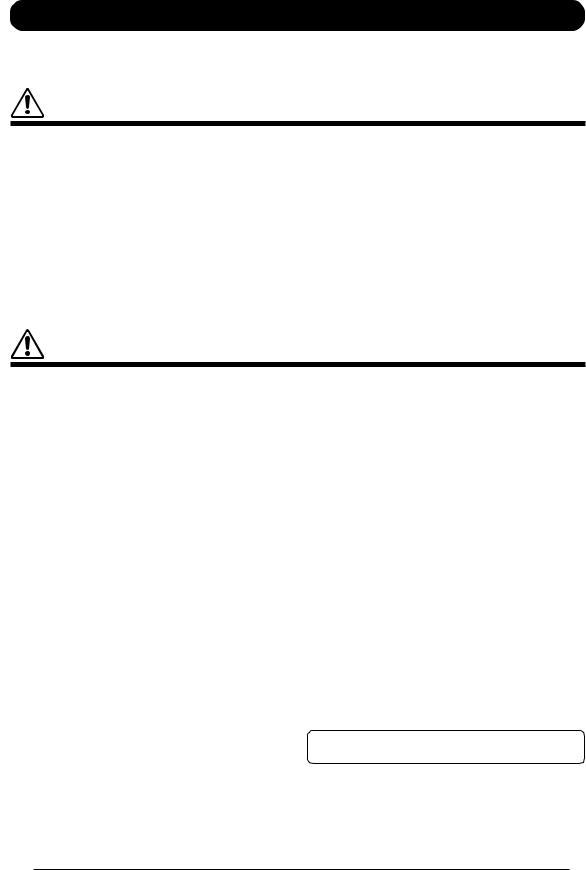
PRECAU T I ON S
PLEASE READ CAREFULLY BEFO RE PRO CEEDI N G
* Please keep these precautions in a safe place for future reference.
W A RN I N G
Always follow the basic precautions listed below to avoid the possibility of serious injury or even death from electrical shock, short-circuiting, damages, fire or other hazards. These precautions include, but are not limited to, the following:
•Do not open the instrument or attempt to disassemble the internal parts or modify them in any way. The instrument contains no userserviceable
parts. If i t shoul d appear to be mal functi oni ng, di sconti nue use i mmedi atel y and have i t i nspected by qual i fi ed Yamaha servi ce personnel.
•Do not expose the instrument to rain, use it near water or in damp or wet conditions, or place containers on it containing liquids which might spill into any openings.
•If the AC adaptor cord or plug becomes frayed or damaged, or if there is a sudden loss of sound during use of the instrument, or if any unusual
smells or smoke should appear to be caused by it, immediately turn off the power switch, disconnect the adaptor plug from the outlet, and have the instrument inspected by qualified Yamaha service personnel.
•Use the specified adaptor (PA5B or an equivalent recommended by Yamaha) only. Using the wrong adaptor can result in damage to the instrument or overheating.
•Before cleaning the instrument, always remove the electric plug from the outlet. Never insert or remove an electric plug with wet hands.
•Check the electric plug periodically and remove any dirt or dust which may have accumulated on it.
CA UTI O N
Always follow the basic precautions listed below to avoid the possibility of physical injury to you or others, or damage to the instrument or other property. These precautions include, but are not limited to, the following:
•Do not place the AC adaptor cord near heat sources such as heaters or radiators, and do not excessively bend or otherwise damage the cord, place heavy objects on it, or place it in a position where anyone could walk on, trip over, or roll anything over it.
•When removing the electric plug from the instrument or an outlet, always hold the plug itself and not the cord.
•Do not connect the instrument to an electrical outlet using a multipleconnector. Doing so can result in lower sound quality, or possibly cause overheating in the outlet.
•Unplug the AC power adaptor when not using the instrument, or during electrical storms.
•Before connecting the instrument to other electronic components, turn off the power for all components. Before turning the power on or off for all components, set all volume levels to minimum.
•Do not expose the instrument to excessive dust or vibrations, or extreme cold or heat (such as in direct sunlight, near a heater, or in a car during the day) to prevent the possibility of panel disfiguration or damage to the internal components.
•Do not use the i nstrument near other el ectri cal products such as televisions, radios, or speakers, since this might cause interference which can affect proper operation of the other products.
•Do not place the instrument in an unstable position where it might accidentally fall over.
•Before moving the instrument, remove all connected adaptor and other cables.
•When cleaning the instrument, use a soft, dry cloth. Do not use paint thinners, solvents, cleaning fluids, or chemical - impregnated wiping cloths. Also, do not place vinyl or plastic objects on the instrument, since this might discolor the panel or keyboard.
•Do not rest your weight on, or place heavy objects on the instrument, and do not use excessive force on the buttons, switches or connectors.
•Do not operate the instrument for a long period of time at a high or uncomfortable volume level, since this can cause permanent hearing loss. If you experience any hearing loss or ringing in the ears, consult a physician.
■REPLACING THE BACKUP BATTERY
•This instrument contains a non rechargeable internal backup battery which permits internal data to remain stored even when the power is off. When the backup battery needs replacing, the message “ Battery Low!” will display in the display. When this happens, immediately back up your data (using an external device such as the floppy diskbased Yamaha M IDI Data Filer M DF2), then have qualified Yamaha service personnel replace the backup battery.
•Do not attempt to replace the backup battery yourself, in order to prevent the possible serious hazards. Always have qualified Yamaha service personnel replace the backup battery.
•Never place the backup battery in a location that a child can reach, since a child might accidentally swallow the battery. If this should happen, consult a physician immediately.
■SAVING USER DATA
•Save all data to an external device such as the Yamaha M IDI Data Filer M DF2, in order to help prevent the loss of important data due to a malfunction or user operating error.
Yamaha cannot be held responsible for damage caused by improper use or modifications to the instrument, or data that is lost or destroyed.
Always turn the power off when the instrument is not in use.
ix
Downloaded from: http://www.usersmanualguide.com/
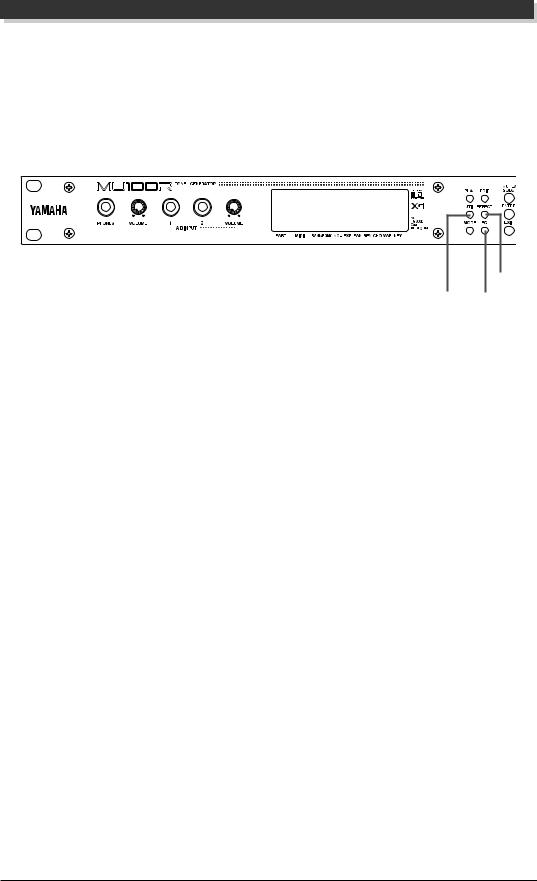
The Controls of the M U 100R
The Controls of the MU100R
Front Panel
1 2 |
3 |
4 |
5 8 |
||||||||||
|
|
|
|
|
|
|
|
|
|
|
|
|
|
|
|
|
|
|
|
|
|
|
|
|
|
|
|
|
|
|
|
|
|
|
|
|
|
|
|
|
|
|
|
|
|
|
|
|
|
|
|
|
|
|
|
|
|
|
|
|
|
|
|
|
|
|
|
|
|
7 9
6 0
1PH O N ES jack
For connection to a set of stereo headphones (1/4” plug).
2VO LU M E control
For adjusting the overall volume of the MU100R.
3A/ D IN PU T 1, 2 jacks
For connection of a microphone, electric guitar or other electronic instruments (mono 1/4” plugs).
4A/ D IN PU T VO LU M E control
For control of the level of the A/D inputs.
5PLAY button
For entering the Play mode and switching among the different Play displays. (See page 24.)
6U TIL (U TILITY) button
For entering the Utility mode. (See page 15.)
7M O D E button
For entering the Sound Module mode. (See page 23.)
8ED IT button
For entering the Edit mode. (See page 36.)
9EFFECT button
For entering the Effect Edit mode. (See page 74.)
:EQ button
For entering the EQ Edit mode. (See page 82.)
1
Downloaded from: http://www.usersmanualguide.com/
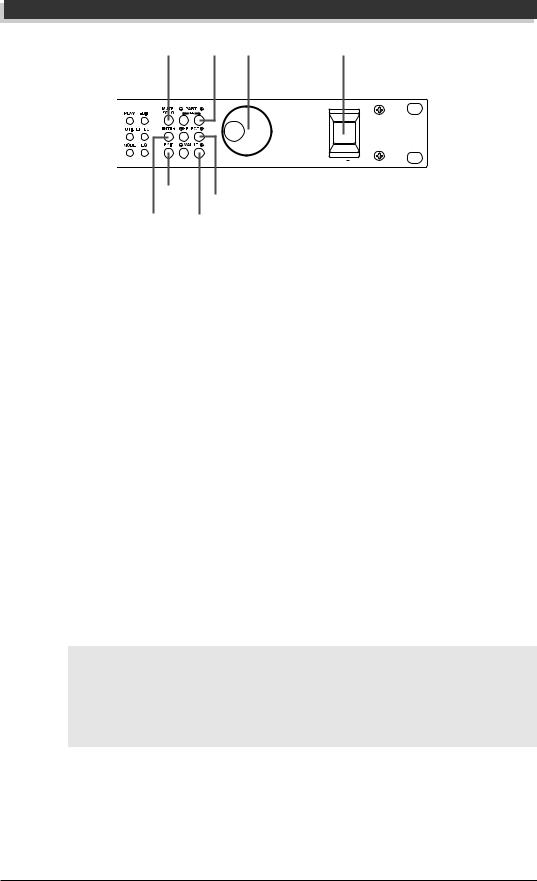
The Controls of the M U 100R
A D G H
POWER
 ON/
ON/  OFF
OFF
C E
B F
AM U TE/ SO LO button
Pressing this alternately mutes or solos the selected Part. (See page 85.)
BEN TER button
For calling up menu items in the display and for executing certain functions and operations. Double-clicking this (pressing it twice quickly) calls up the Show Exclusive function (see page 175).
CEXIT button
For leaving various display pages and returning to previous displays. Also for canceling certain functions and operations.
DPART -/ + buttons
For selecting different Parts. In the Effect Edit mode, these can be used to switch among the different effects. Pressing these together alternately switches between All Part and Single Part control. (See page 48.)
ESELECT </ > buttons
For selecting the various menu items, parameters and controls on the display.
FVALU E -/ + buttons
For changing the value of a selected parameter or control.
H int
You can rapidly move through the values by holding down one of the [VALUE -/+] buttons. You can move even more rapidly by holding down one button and then pressing and holding down the other. For example, to rapidly advance (increase) the value, hold down the [VALUE +] button and simultaneously press and hold down the [VALUE -] button.
GD ata dial
For rapidly adjusting/changing values of the selected function or parameter. Rotate this clockwise to increase the value.
HPO W ER switch
Pressing this turns the power on and off.
2
Downloaded from: http://www.usersmanualguide.com/
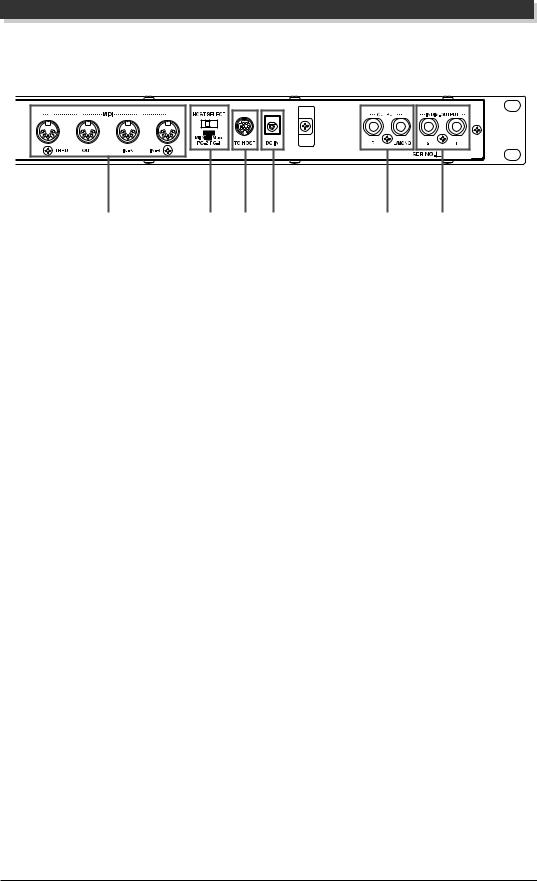
The Controls of the M U 100R
Rear Panel
1 |
2 3 4 |
5 |
6 |
1M ID I TH RU , M ID I O U T and M ID I IN A/ B terminals
For connection to other MIDI devices, such as a MIDI keyboard, tone generator, sequencer, or to a computer that has a MIDI interface. MIDI IN A and B are independent MIDI ports, allowing full 32-channel MIDI input. MIDI OUT is for data dumps to another MIDI device, while MIDI THRU is for “daisychain” connection of additional MU100Rs or other MIDI instruments. (See page 17 for more information on MIDI connections.)
2H O ST SELECT switch
For selecting the type of host computer. (See page 19.)
3TO H O ST terminal
For connection to a host computer that does not have a MIDI interface. (See page 19.)
4D C IN jack
For connection to the PA-5B AC power adaptor.
5O U TPU T R, L/ M O N O jacks (Right, Left/ M ono)
For connection to a stereo amplifier/speaker system. When using a mono system, connect it to the L/MONO jack.
6IN D IV. (Individual) O U TPU T 1, 2 jacks
For independent output of selected Parts (1/4” jack). Parts selected for output through these jacks are not output through the main OUTPUT or PHONES jacks. (See pages 113 and 118.)
3
Downloaded from: http://www.usersmanualguide.com/

The M U 100R — W hat It Is and W hat It Can D o
The MU100R — What It Is and What It Can Do
What It Is...
The MU100R is a full-featured and easy-to-use tone generator, that provides an unprecedented wealth of Voices and expressive sonic control. It features full General MIDI Level 1 compatibility with 128 General MIDI Voices and 9 drum kits. It also provides new XG-MIDI (Extended General MIDI) compatibility, with an huge total of 1074 Voices and 36 drum kits. Moreover, it has an integrated VL tone generator that provides 256 stunning monophonic Voices utilizing Yamaha’s sophisticated Virtual Acoustic Synthesis system.
The MU100R has 64-note polyphony and is 32-Part multi-timbral. In other words, the MU100R has 32 different Parts, each with its own Voice, so that up to 32 different Voices can be sounded simultaneously. Since the MU100R features dual MIDI input ports (A and B), 16 Parts can be played from one MIDI port and the remaining 16 from the other port.
Additional A/D Parts let you connect up to two external signals — such as a microphone, electric guitar or CD player — and mix them with the MU100R’s Voices.
The MU100R also has a TO HOST terminal for easy interfacing with a computer, allowing you to play the Voices using your favorite music software. This is where the advanced multi-timbral capabilities come in, letting you playing sophisticated arrangements using up to 32 different Voices at the same time.
Although Voices cannot be directly edited, the various Part controls and Edit mode give you tools for transforming or customizing the sound of the Voices. What’s more, the MU100R has a built-in multi-effect processor, with seven independent digital effect “units” for enhancing the sound. Included in these is a powerful Harmony section that allows you to generate realistic vocal harmonies with your actual voice (using one of the A/D Parts).
The MU100R also features a special Performance mode, in which four Parts are played simultaneously over a single MIDI channel. Connected to a MIDI keyboard, this effectively gives you four tone generators in one. The MU100R gives you 100 factory-programmed Preset Performances plus 100 Internal Performance locations for storing your own original Performances.
About General MIDI
General MIDI is a new addition to the worldwide MIDI standard. MIDI, as you know, stands for Musical Instrument Digital Interface, and makes it possible for various electronic musical instruments and other devices to “communicate” with each other. For example, by connecting a sequencer to the MU100R’s MIDI IN terminal, you could play back a song on the sequencer using the Voices of the MU100R.
4
Downloaded from: http://www.usersmanualguide.com/

The M U 100R — W hat It Is and W hat It Can D o
So, where does General MIDI fit in all of this? One of the most important features of General MIDI is in the standardization of Voices. This means that a song recorded in the General MIDI format can be played back on any General MIDI compatible tone generator and sound just as the composer intended. For example, if there is an alto sax solo in the song, it will be played by an alto sax Voice on the General MIDI tone generator (and not by a tuba or harpsichord!). Since the MU100R is fully compatible with General MIDI, you can take advantage of the vast wealth of musical material recorded in that format.
About XG-MIDI
The new XG format is an extension of General MIDI, and provides a number of significant improvements and enhancements. XG-compatible song data takes advantage of the extensive MIDI control and built-in effects of the MU100R (and other MU-series instruments).
To take greatest advantage of the powerful capabilities of XG-MIDI, we recommend using XG-compatible instruments and software. For example, XGcompatible keyboards such as the Yamaha CBX-K1 keyboard and software give you direct controls for accessing the full expressive potential of the MU100R’s XG Voices and the XG-related parameters.
What It Can Do...
Here are a few ideas on how you can use the MU100R. The list below is not comprehensive, but is meant to be a general guide to the possibilities and provide a starting point or springboard for your own creative ideas and explorations.
Using With MIDI Keyboard
Use the MU100R as supplementary tone generator with your MIDI keyboard and play the Voices of both instruments in a layer together. Or, use the convenient Performance mode, and play four Voices on the MU100R at once. You can split the four Voices across the keyboard, playing each from a different register. Or you can create sophisticated velocity splits, in which a different Voice is heard depending on how strongly you play the keyboard. Or use keyboard and velocity splits together for even greater flexibility.
Using With a Computer or Sequencer
Home Studio Setup
The MU100R integrates instantly and easily into any existing setup. If you have a MIDI keyboard, computer and sequencing software, the MU100R with its highquality Voices and multi-timbral capabilities can expand your home studio system.
5
Downloaded from: http://www.usersmanualguide.com/

The M U 100R — W hat It Is and W hat It Can D o
Carry It With You
If you have a laptop computer (and sequencing software), simply connect the MU100R, plug in some headphones and you’ve got a complete, high-powered music making system that’s ready to go wherever you go. Use it for composing, arranging, practicing or making/playing demos for your band.
Use It on a Gig
Similarly, you can connect a laptop or a MIDI data filer and playback song data with the MU100R’s Voices. Plug a microphone into one of the A/D inputs and a guitar into the other, and you can mix your own live performance with the sequencer tracks. What’s more, you can produce automatic vocal harmonies with the Harmony effect
— controlled either from a keyboard or directly from one of the sequencer tracks!
Multimedia
Since it’s compatible with General MIDI and XG, the MU100R is a natural for multimedia applications. Bring it with you to a presentation — since the computer interface is built-in to the MU100R, it hooks up instantly and easily to the computer’s serial port or printer port, without the need for any other equipment.
About the Modes of the MU100R
The MU100R has two main operating modes: Multi and Performance. In Multi mode, the MU100R is a 32-Part multi-timbral tone generator; in Performance mode, the MU100R effectively functions as four tone generators controlled over a single MIDI channel.
Which mode the MU100R is in depends on the selected Sound Module mode. If XG, TG300B or C/M are selected, the MU100R automatically sets itself to the Multi mode. When PFM is selected, the MU100R is in the Performance mode. (For information on selecting the Sound Module mode, see page 172.)
Each mode provides compatibility with different music software and hardware.
XG: This stands for Extended General MIDI and provides the full potential of the MU100R, giving you access to the 1074 XG Voices plus the VL Voices.
TG300B: This mode provides compatibility with the GM-B mode of the TG300 Tone Generator.
C/ M : This mode provides compatibility with most computer music software not supported by the other two Multi modes.
PFM : This mode (Performance) lets you play four Voices simultaneously over a single MIDI channel. (For more information on using the Performance mode, see page 43.)
6
Downloaded from: http://www.usersmanualguide.com/
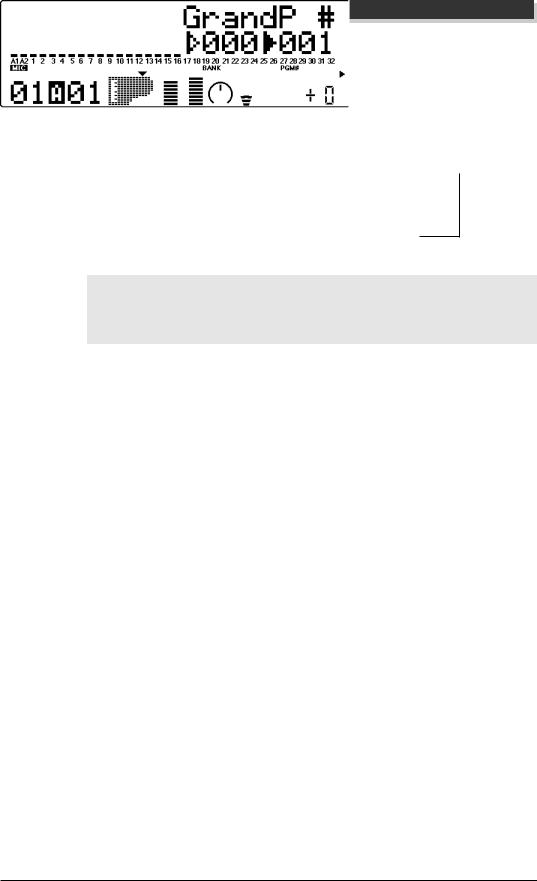
The M U 100R — W hat It Is and W hat It Can D o
The bottom right of the display indicates the currently selected Sound Module mode.
XG
TG300B
C/M
PERFORM
Selected Sound Module mode.
N O TE
When set to the TG300B mode, the MU100R may not be able to play TG300-spe- cific song data with complete accuracy. However, MIDI data designed for other computer music tone generators is compatible with the MU100R.
Play Modes and the Part Controls
Once the operating mode of the MU100R is set (Multi or Performance), there are two main ways you can use the MU100R: playing and editing. In the Play modes, you play the Voices; in the various Edit modes, you change their settings.
Within the Play modes are the Part controls. These let you make basic settings for the Parts. The Single Part controls allow you to make independent settings for each Part, while the All Part controls allow you to change the overall settings of all Parts. (See pages 96 and 98 for more information.) The MU100R has several different Edit modes, each with various menus and operations:
Part Edit Mode
The Part Edit mode allows you to change certain settings for each individual Part, such as those of the Filter, EG (Envelope Generator), and many other settings. The internal Voices can be sounded during editing, allowing you to hear the effects of your edits.
Utility Mode
The Utility mode lets you set functions related to the overall operation of the MU100R, such as Master Tune, display Contrast and reception of certain MIDI messages that affect the entire instrument. Included also are miscellaneous operations, such as sending bulk data to a data storage device, initializing of the MU100R settings, and playing the special Demo song.
7
Downloaded from: http://www.usersmanualguide.com/

M odes and Function Tree
Modes and Function Tree
[PLAY] |
Multi Play Mode ( When the sound module mode is “XG”, “TG300B”, or “C/M”) |
P. 95 |
||
|
|
|
|
|
|
|
[SELECT </>] Multi Part Control |
|
|
|
|
|
P. 96 |
|
[PART++-] |
|
[SELECT </>] Multi All Part Control |
P. 98 |
|
|
|
Multi Part Edit Mode |
|
|
|
|
|
|
|
|
|
|
|
|
|
|
|
|
|
|
|
|
|
|
|
|
|
|
|
|||||
|
[EDIT] |
|
|
|
|
|
|
|
|
|
|
|
|
|
|
|
|
|
|
|
|
|
|
|
|
|
|
P. 100 |
|||||||
|
|
|
|
|
|
|
|
|
|
|
|
|
|
|
|
|
|
|
|
|
|
|
|
|
|
|
|
|
|
|
|
|
|
||
|
|
|
|
|
[SELECT <] Filter Edit |
[ENTER] |
|
|
|
|
|
|
|
|
|
|
|
|
|
|
|
|
P. 100 |
||||||||||||
|
|
|
|
|
|
|
|
|
|
|
|
|
|
|
|
|
|
|
|
|
|
|
|
|
|
|
|
|
|
|
|
|
|
|
|
|
|
|
|
|
[SELECT </>] EG Edit |
[ENTER] |
|
|
|
|
|
|
|
|
|
|
|
|
|
P. 102 |
|||||||||||||||
|
|
|
|
|
|
|
|
|
|
|
|
|
|
|
|
|
|
|
|
|
|
|
|
|
|
|
|
|
|
|
|
|
|
|
|
|
|
|
|
|
[SELECT </>] EQ Edit |
(Only when Normal or VL Part is selected.) [ENTER] |
|
|
P. 105 |
||||||||||||||||||||||||||
|
|
|
|
|
|
|
|
|
|
|
|
|
|
|
|
|
|
|
|
|
|
|
|
|
|
|
|
|
|
|
|
|
|
|
|
|
|
|
|
|
[SELECT </>] Drum Setup Edit (Only when Drum Part is selected.) [ENTER] |
|
P. 114 |
||||||||||||||||||||||||||||
|
|
|
|
|
|
|
|
|
|
|
|
|
|
|
|
|
|
|
|
|
|
|
|
|
|
|
|
|
|
|
|
|
|
|
|
|
|
|
|
|
[SELECT </>] Vibrato Edit |
|
[ENTER] |
|
|
|
|
|
|
|
|
|
|
|
|
|
P. 106 |
||||||||||||||
|
|
|
|
|
|
|
|
|
|
|
|
|
|
|
|
|
|
|
|
|
|
|
|
|
|
|
|
|
|
|
|
|
|
|
|
|
|
|
|
|
[SELECT </>] Others Edit |
[ENTER] |
|
|
|
|
|
|
|
|
|
|
|
|
|
P. 107 |
|||||||||||||||
|
|
|
|
|
|
|
|
|
|
|
P. 119 |
||||||||||||||||||||||||
|
|
|
|
|
|
|
|
|
|
|
|
|
|
|
|
|
|
|
|
|
|
|
|
|
|
|
|
|
|
|
|
|
|
|
|
|
|
|
|
|
[SELECT >] Plugin Edit |
(Only when VL Part is selected.) [ENTER] |
|
||||||||||||||||||||||||||||
|
|
|
|
|
|
|
|
|
|
|
|
|
|
|
|
|
|
|
|
|
|
|
|
|
|
|
|
|
|
|
|
|
|
|
|
[PLAY] |
Performance Play Mode ( When the sound module mode is ”PFM”) |
|
|
|
|
|
|
|
|
|
|
|
|
P. 127 |
|||||||||||||||||||||
|
|
|
|
|
|
|
|
|
|
|
|
|
|
|
|
|
|
|
|
|
|
|
|
|
|
|
|
|
|
|
|
|
|
|
|
|
|
[SELECT </>] Performance Control |
|
|
|
|
|
|
|
|
|
|
|
|
|
|
|
|
|
|
|
|
|
|
|
|
|
|
|
|
|
||||
|
|
|
|
|
|
|
|
|
|
|
|
|
|
|
|
|
|
|
|
|
|
|
|
|
|
|
|
|
|
P. 128 |
|||||
|
|
|
|
|
|
|
|
|
|
|
|
|
|
|
|
|
|
|
|
|
|
|
|
|
|
|
|
|
|
|
|
||||
|
|
|
|
[PART++-] |
|
|
|
|
|
|
|
|
|
|
|
|
|
|
|
|
|
|
|
|
|
|
|
|
|
|
|
||||
|
|
|
|
|
|
|
|
|
|
|
|
|
|
|
|
|
|
|
|
|
|
|
|
|
|
|
|
|
|
|
|
|
|
|
|
|
|
[SELECT </>] Performance Part Control |
|
|
|
|
|
|
|
|
|
|
|
|
|
|
|
|
|
|
|
|
|
|
|
|
|
|
|
||||||
|
|
|
|
|
|
|
|
|
|
|
|
|
|
|
|
|
|
|
|
|
|
|
|
|
|
|
|
P. 129 |
|||||||
|
|
|
|
|
|
|
|
|
|
|
|
|
|
|
|
|
|
|
|
|
|
|
|
|
|
|
|
|
|
|
|
|
|
|
|
|
|
[EDIT] |
Performance Edit Mode |
|
|
|
|
|
|
|
|
|
|
|
|
|
|
|
|
|
|
|
|
|
|
|
|
|
|
P. 131 |
|||||
|
|
|
|
|
|
|
|
|
|
|
|
|
|
|
|
|
|
|
|
|
|
|
|
|
|
|
|
|
|
|
|
|
|
|
|
|
|
|
|
|
|
[SELECT <] Common Edit |
[ENTER] |
|
|
|
|
|
|
|
|
|
|
|
|
|
|
P. 131 |
|||||||||||||
|
|
|
|
|
|
|
|
|
|
|
|
|
|
|
|
|
|
|
|
|
|
|
|
|
|
|
|
|
|
|
|
|
|
|
|
|
|
|
|
|
|
[SELECT </>] Part Edit |
[ENTER] |
|
|
|
|
|
|
|
|
|
|
|
|
|
|
|
|
P. 134 |
|||||||||||
|
|
|
|
|
|
|
|
|
|
|
|
|
|
|
|
|
|
|
|
|
|
|
|
|
|
|
|
|
|
|
|
|
|
|
|
|
|
|
|
|
|
|
|
|
|
|
[SELECT <] Filter Edit [ENTER] |
|
|
|
|
|
|
|
|
|
P. 135 |
||||||||||||||
|
|
|
|
|
|
|
|
|
|
|
|
|
|
|
|
|
|
|
|
|
|
|
|
|
|
|
|
|
|
|
|
|
|
|
|
|
|
|
|
|
|
|
|
|
|
|
[SELECT </>] EG Edit |
[ENTER] |
|
|
|
|
|
|
|
|
P. 135 |
||||||||||||||
|
|
|
|
|
|
|
|
|
|
|
|
|
|
|
|
|
|
|
|
|
|
|
|
|
|
|
|
|
|
|
|
|
|
|
|
|
|
|
|
|
|
|
|
|
|
|
[SELECT </>] EQ Edit |
[ENTER] |
|
|
|
|
|
|
|
|
P. 135 |
||||||||||||||
|
|
|
|
|
|
|
|
|
|
|
|
|
|
|
|
|
|
|
|
|
|
|
|
|
|
|
|
|
|
|
|
|
|
|
|
|
|
|
|
|
|
|
|
|
|
|
[SELECT </>] Vibrato Edit |
[ENTER] |
|
|
|
|
|
|
P. 135 |
||||||||||||||||
|
|
|
|
|
|
|
|
|
|
|
|
|
|
|
|
|
|
|
|
|
|
|
|
|
|
|
|
|
|
|
|
|
|
|
|
|
|
|
|
|
|
|
|
|
|
|
[SELECT </>] Others Edit |
[ENTER] |
|
|
|
|
|
|
P. 135 |
||||||||||||||||
|
|
|
|
|
|
|
|
|
|
|
|
|
|
|
|
||||||||||||||||||||
|
|
|
|
|
|
|
|
|
|
|
|
|
|
|
|
|
|
|
|
|
|
|
|
|
|
|
|
|
|
|
|
|
|
|
|
|
|
|
|
|
|
|
|
|
|
|
[SELECT >] Plugin Edit (Only when VL Part is selected.) [ENTER] |
|
P. 136 |
||||||||||||||||||||||
|
|
|
|
|
|
|
|
|
|
|
|
|
|
|
|
|
|
|
|
|
|
|
|
|
|
|
|
|
|
|
|
|
|
|
|
|
|
|
|
|
[SELECT </>] Copy |
[ENTER] |
|
|
|
|
|
|
|
|
|
|
|
|
|
|
|
|
|
|
P. 137 |
||||||||||
|
|
|
|
|
|
|
|
|
|
|
|
|
|
|
|
|
|
|
|
|
|
|
|
|
|
|
|
|
|
|
|
|
|
|
|
|
|
|
|
|
[SELECT </>] Store |
[ENTER] |
|
|
|
|
|
|
|
|
|
|
|
|
|
|
|
|
|
|
P. 138 |
||||||||||
|
|
|
|
|
|
|
|
|
|
|
|
|
|
|
|
|
|
|
|
|
|
|
|
|
|
|
|
|
|
|
|
|
|
|
|
|
|
|
|
|
[SELECT >] Recall [ENTER] |
|
|
|
|
|
|
|
|
|
|
|
|
|
|
|
|
|
|
P. 140 |
|||||||||||
8
Downloaded from: http://www.usersmanualguide.com/
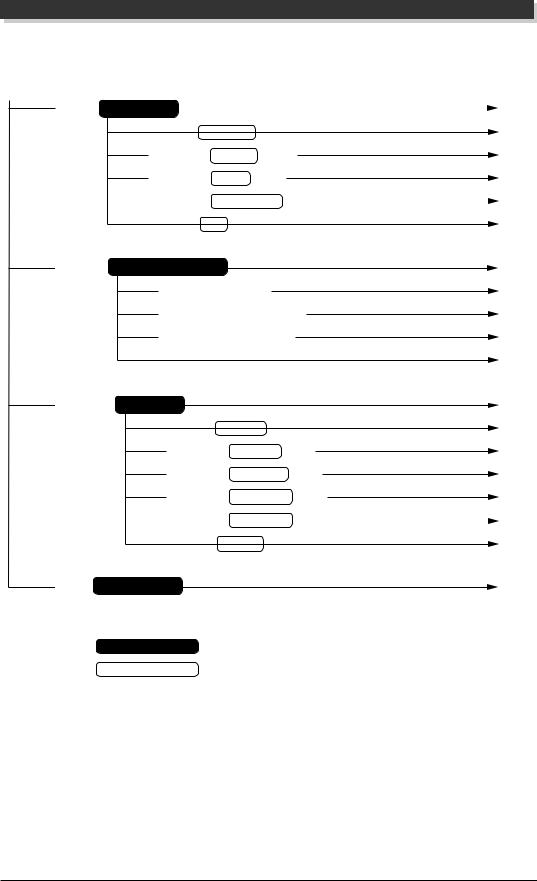
M odes and Function Tree
[UTIL] |
Utility Mode |
|
|
|
|
|
|
|
|
|
|
|
|
|
|
|
|
|
|
|
|
|
P. 156 |
||||||
|
|
|
|
|
|
|
|
|
|
|
|
|
|
|
|
|
|
|
|
||||||||||
|
|
|
|
|
|
|
|
|
|
|
|
|
|
|
|
|
|
|
|
|
|
|
|||||||
|
|
|
|
|
[SELECT <] System Setup |
|
|
|
|
|
|
|
|
|
|
|
|
|
|
||||||||||
|
|
|
|
|
[ENTER] |
|
|
|
|
|
|
|
|
|
|
|
|
P. 157 |
|||||||||||
|
|
|
|
|
|
|
|
|
|
|
|
|
|
|
|
|
|
|
|
|
|
|
|
|
|
|
|
|
|
|
|
|
|
|
[SELECT </>] Dump Out |
|
|
|
|
|
|
|
|
||||||||||||||||
|
|
|
|
|
[ENTER] |
|
|
|
|
|
|
|
|
|
|
|
P. 161 |
||||||||||||
|
|
|
|
|
|
|
|
|
|
|
|
|
|
|
|
|
|
|
|
|
|
|
|
|
|
|
|
|
|
|
|
|
|
|
[SELECT </>] |
Initialize [ENTER] |
|
|
|
|
|
|
|
|
|
|
|
|
|
|
|
||||||||
|
|
|
|
|
|
|
|
|
|
|
|
|
|
|
|
|
|
|
P. 165 |
||||||||||
|
|
|
|
|
|
|
|
|
|
|
|
|
|
|
|
|
|
|
|
|
|
|
|
|
|
|
|
|
|
|
|
|
|
|
[SELECT </>] |
Demo Song Play [ENTER] |
|
|
|
|
|
|
|
||||||||||||||||
|
|
|
|
|
|
|
|
|
|
|
P. 168 |
||||||||||||||||||
|
|
|
|
|
|
|
|
|
|||||||||||||||||||||
|
|
|
|
|
|
|
|
|
|
|
|
|
|
|
|
|
|
|
|
|
|
|
|||||||
|
|
|
|
|
[SELECT >] Plugin |
[ENTER] |
|
|
|
|
|
|
|
|
|
|
|
|
|
|
|
|
|||||||
|
|
|
|
|
|
|
|
|
|
|
|
|
|
|
|
|
|
|
|
|
|
P. 169 |
|||||||
|
|
Sound Module Mode |
|
|
|
|
|
|
|
|
|
|
|
|
|
|
|
|
|
|
|
|
|||||||
|
|
|
|
|
|
|
|
|
|
|
|
|
|
|
|
|
|
|
|
|
|
||||||||
[MODE] |
|
|
|
|
|
|
|
|
|
|
|
|
|
|
|
|
|
|
|
|
P. 172 |
||||||||
|
|
|
|
|
|
|
|
|
|
|
|
|
|
|
|
|
|
|
|
|
|
|
|
|
|
|
|
|
|
|
|
|
|
|
|
[SELECT <] or [VALUE-] XG |
|
|
|
|
|
|
|
|
|
|
|
|
|
|
|
|
|
||||||
|
|
|
|
|
|
|
|
|
|
|
|
|
|
|
|
|
|
|
|
|
|
P. 172 |
|||||||
|
|
|
|
|
|
|
|
|
|
|
|
|
|
|
|
|
|
|
|
|
|
|
|
|
|
|
|
|
|
|
|
|
|
|
|
[SELECT </>] or [VALUE+/-] TG300 |
|
|
|
|
|
|
P. 172 |
||||||||||||||||
|
|
|
|
|
|
|
|
|
|
|
|
|
|
|
|
|
|
|
|
||||||||||
|
|
|
|
|
|
[SELECT </>] or [VALUE+/-] C/M |
|
|
|
|
|
|
|
|
P. 172 |
||||||||||||||
|
|
|
|
|
|
|
|
|
|
|
|
|
|
|
|
|
|
|
|
|
|||||||||
|
|
|
|
|
|
[SELECT >] or [VALUE+] PFM |
|
|
|
|
|
|
|
|
|
|
|
|
|
|
P. 172 |
||||||||
[EFFECT] |
|
Effect Mode |
|
|
|
|
|
|
|
|
|
|
|
|
|
|
|
|
|
|
|
|
P. 141 |
||||||
|
|
|
|
|
|
|
|
|
|
|
|
|
|
|
|
|
|
|
|||||||||||
|
|
|
|
|
|
|
[SELECT <] Reverb Edit [ENTER] |
|
|
|
|
|
|
P. 142 |
|||||||||||||||
|
|
|
|
|
|
|
|
|
|
|
|
|
|
|
|
|
|
|
|||||||||||
|
|
|
|
|
|
|
[SELECT </>] |
Chorus Edit [ENTER] |
|
|
|
|
|
P. 143 |
|||||||||||||||
|
|
|
|
|
|
|
|
|
|
|
|
|
|
|
|
|
|
|
|||||||||||
|
|
|
|
|
|
|
[SELECT </>] |
Variation Edit |
[ENTER] |
|
|
|
|
P. 144 |
|||||||||||||||
|
|
|
|
|
|
|
|
|
|
|
|
|
|
|
|
|
|
|
|||||||||||
|
|
|
|
|
|
|
[SELECT </>] |
Insertion 1 Edit |
|
[ENTER] |
|
|
|
P. 146 |
|||||||||||||||
|
|
|
|
|
|
|
|
|
|
|
|
|
|
|
|
|
|
|
|
||||||||||
|
|
|
|
|
|
|
[SELECT </>] |
Insertion 2 Edit |
|
[ENTER] |
|
|
|
P. 146 |
|||||||||||||||
|
|
|
|
|
|
|
|
|
|||||||||||||||||||||
|
|
|
|
|
|
|
|
|
|
|
|
|
|||||||||||||||||
|
|
|
|
|
|
|
[SELECT >] |
Plugin Edit [ENTER] |
|
|
|
P. 147 |
|||||||||||||||||
[EQ] |
Equalizer Mode |
|
|
|
|
|
|
|
|
|
|
|
|
|
|
|
|
|
|
|
|
|
|||||||
|
|
|
|
|
|
|
|
|
|
|
|
|
|
|
|
|
|
|
|
P. 155 |
|||||||||
: Mode
: Submode
Push on the SELECT buttons either < or > for SELECT < / >.
Push on the PART + and - simultaneously for PART ++ -.
9
Downloaded from: http://www.usersmanualguide.com/

10
Downloaded from: http://www.usersmanualguide.com/

GUIDED TOUR
W hen using your M U 100R for the first time, read through this short section of the manual. It guides you step-by-step in using many of the basic operations: setting the instrument up, connecting it properly to other equipment, and — mo st importantly — playing it. It also introduces you to m ost of the other, advanced features and operations of the instrument — enabling you to quickly and effectively get the most out of your new M U 100R.
Downloaded from: http://www.usersmanualguide.com/

Setting U p Your M U 100R
Setting Up Your MU100R
In this section, you’ll learn how to:
©Connect the M U 100R in the most basic setup — with a MIDI keyboard and an external amplifier/speaker system.
Other setup examples are covered in later sections; for example, setting up for use with a computer is on page 19. Once you’ve set up the MU100R, we urge you to play the Demo song (page 15) and hear what the instrument is capable of.
What You’ll Need
The M U 100R and the included PA-5B power adaptor.
A M ID I keyboard, electronic piano, or any instrument that can output
M ID I data.
An amplifier/ speaker system, preferably stereo. Alternately, you can use a set of stereo headphones.
Audio connecting cables.
A M ID I cable.
Making the Connections
CAU TIO N !
Before making any connections, turn all related equipment off, and make sure the MU100R power adaptor is not connected to an electrical outlet.
O peration
1Connect the MIDI cable.
Connect the MIDI OUT terminal of the MIDI keyboard to the MIDI IN-A of the MU100R (as shown in the illustration).
2Connect the audio cables.
Connect the R and L/MONO OUTPUT jacks of the MU100R to the appropriate inputs on the amplifier speaker system (as shown in the illustration).
•If the amplifier has only one input, use the L/MONO jack on the MU100R. If you are using stereo headphones, connect them to the front panel PHONES jack.
|
|
|
12 |
Guided Tour |
|
Downloaded from: http://www.usersmanualguide.com/

Setting U p Your M U 100R
3Set the HOST SELECT switch.
Set this rear panel switch to MIDI (see illustration).
4Connect the AC power adaptor.
Plug the DC output cable of the PA-5B into the DC IN terminal on the rear panel, then plug the adaptor into an appropriate electrical outlet.
•Wrap the DC output cable of the adaptor around the cable clip (as shown below) to prevent accidental unplugging of the cable during operation.
CAU TIO N !
•Do not attempt to use an AC adaptor other than the PA-5B. The use of an incompatible adaptor may result in irreparable damage to the MU100R, and even pose a serious shock hazard.
•Be sure to disconnect the power adaptor from the outlet when the MU100R is not in use.
Amplifier |
Power |
|
Speaker System |
Adaptor |
|
L/MONO |
R |
DC IN |
PHONES 
PITCH
SHIFT
OCTAVE
OCTAVE SHIFT
OCTAVE
RESET
MIDI IN-A
POWER
ON/ OFF |
MIDI CABLE |
|
|
|
MIDI OUT |
IN MIDI OUT |
DC IN POWER ON OFF |
CONTROLLER NUMBER LIST |
|
ASSIGNABLE |
MIDI KEYBOARD CBX-K1 |
SEQUENCER |
PROGRAM |
RESET |
SYSTEM |
WHEEL ASSIGN |
TRANSPOSE |
ENTER |
MIDI Keyboard
Now that you’ve set up the MU100R, we urge you to go on to the next section, turn on the instrument, and play the Demo song (page 15) to hear what the instrument is capable of. If you need information on setting up the MU100R for a different type of system, refer to “ Setting Up the MU100R in Your Music System” on page 17.
Guided Tour |
13 |
Downloaded from: http://www.usersmanualguide.com/
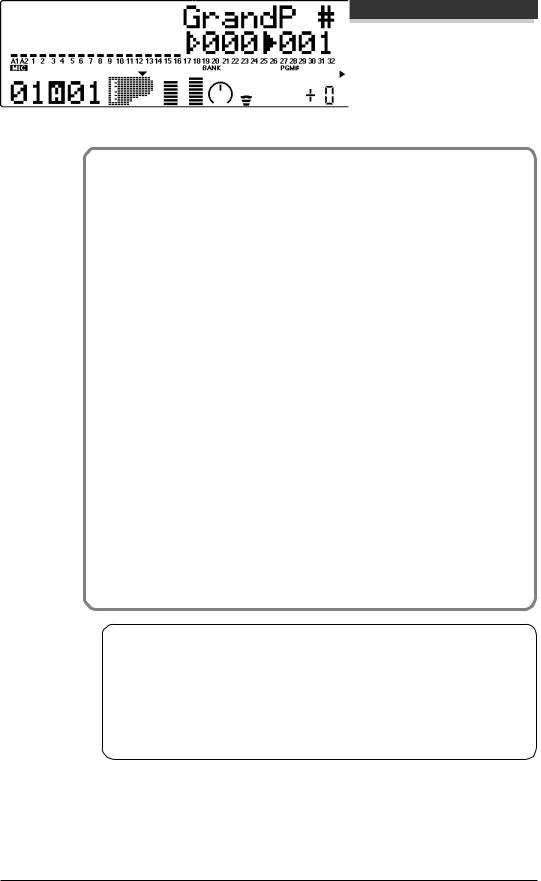
Powering U p
Powering Up
Admittedly this is a simple operation, but you should be careful to follow the instructions below to avoid possible damage to your equipment and speakers.
O peration
1Turn on the power of your MIDI keyboard.
2Turn on the power of the MU100R. Press the POWER switch.
After the animated greeting display finishes, the following display appears:
3Turn down all volume controls.
This includes the MU100R and any connected equipment.
4Turn on the amplifier/speaker system.
5Set the volume controls.
First, set the volume control on the MU100R to about the midway position, then set the volume on the amplifier to a suitable level.
Powering D own
When you turn the power off, make sure to do it in the following order:
1)Amplifier/speaker system
2)MU100R
3)Other connected equipment (MIDI keyboard, etc.)
This prevents possible damage to the speakers.
14 |
Guided Tour |
Downloaded from: http://www.usersmanualguide.com/
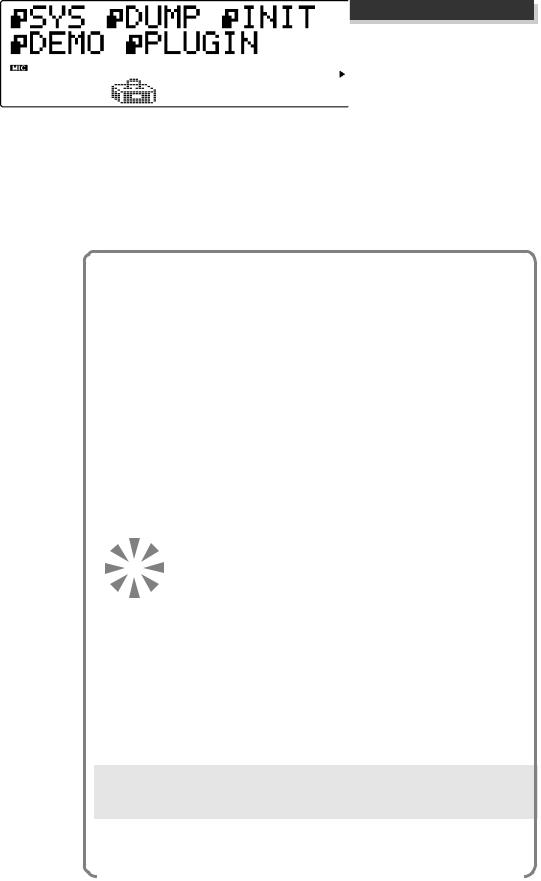
Playing the D emo Song
Playing the Demo Song
Now that you’ve set everything up properly, try playing the built-in Demo song. This showcases the high-quality Voices and the AWM2 tone generation system of the MU100R. It also is an excellent demonstration of the 32part multi-timbral capacity and the various expressive controls and effects that can be used simultaneously. Most importantly, the Demo song will give you an idea of how powerful the MU100R can be in your own MIDI/computer music setup.
O peration
1 Press the [U TIL] button.
2Select and open the DEMO menu.
Use the [SELECT -/ >] buttons to select “DEMO” (the menu icon flashes), then press the [EN TER] button.
3Start the Demo song.
Press the [EN TER] button. The Demo Song starts playing immediately and repeats indefinitely until stopped (in step 4 below). Playback of the individual Parts of the song is shown graphically by the “level meter” bars in the display.
N O TE
During Demo Song playback, none of the panel controls (with the exception of the [EXIT] button and the VOLUME control) can be used.
|
|
|
Guided Tour |
15 |
|
Downloaded from: http://www.usersmanualguide.com/

Playing the D emo Song
4 Stop playback of the song. Press the [EXIT] button.
5Exit from the Demo Song function.
Press the [EXI T] button again — twice to return to the Play mode. (Or you can simply press the [PLAY] button.)
16 |
Guided Tour |
Downloaded from: http://www.usersmanualguide.com/
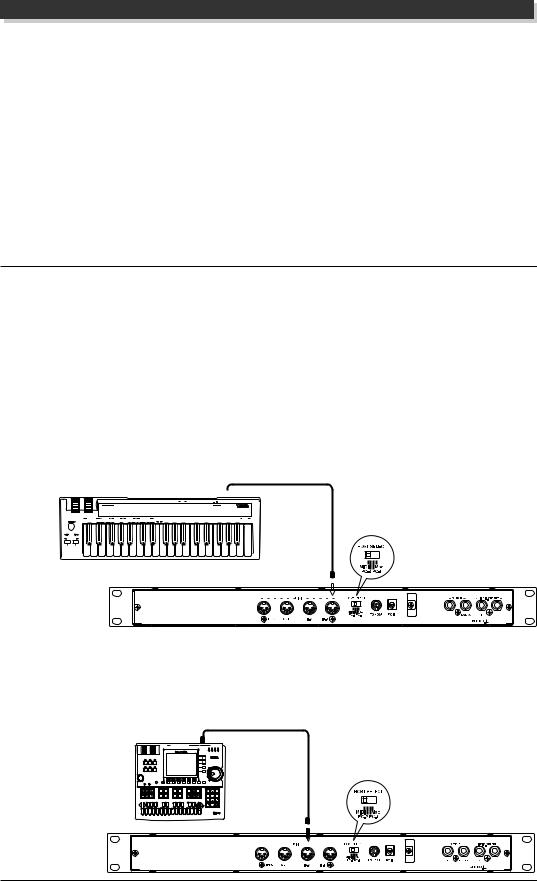
Setting U p the M U 100R in Your M usic System
Setting Up the MU100R in Your Music System
As you learned in the section The MU100R — What It Is and What It Can Do on page 4, the MU100R can be integrated into a variety of setups. It would be impossible to cover all connection possibilities in a short manual as this; however, the section below will help in quickly setting up the MU100R and using it in your system.
Connecting to MIDI Devices
The MU100R is equipped with MIDI IN, OUT, and THRU terminals, allowing you to use it in any MIDI system. Moreover, the two MIDI IN terminals are independent 16-channel ports, effectively giving you two tone generators in one. Here are some common connection examples using the built-in MIDI interface. Refer to the example that most closely matches your setup, then read the Operation steps at the end of this section.
• M ID I keyboard
In this setup, you can play the sounds of the MU100R from the connected keyboard.
MIDI CABLE
MIDI OUT 
CONTROLLER NUMBER LIST
ASSIGNABLE
MIDI Keyboard
MIDI IN-A or B
• H ardware sequencer
In this setup, a hardware sequencer (such as the Yamaha QY700) is used. The main advantage of such a setup is its portability.
MIDI CABLE
MIDI OUT
-
MIDI IN-A 
Guided Tour |
17 |
Downloaded from: http://www.usersmanualguide.com/
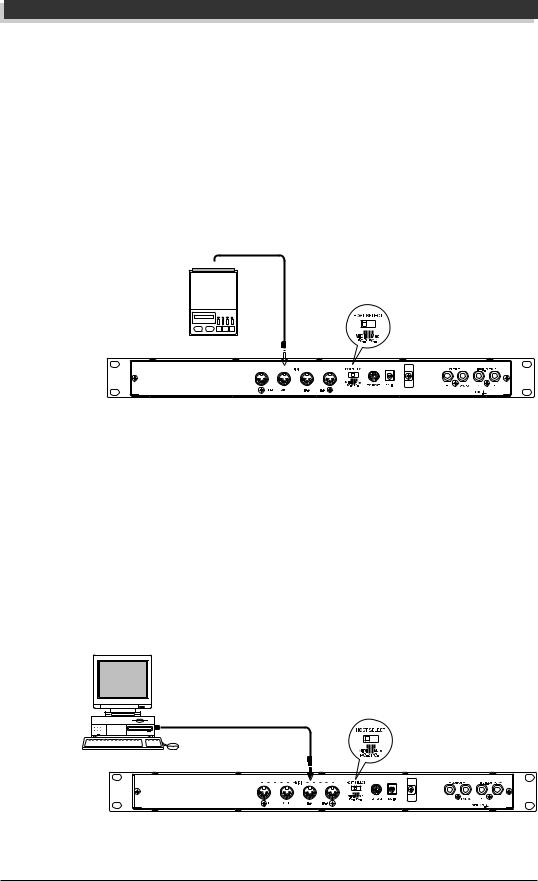
Setting U p the M U 100R in Your M usic System
• M ID I data storage device
This setup is used for backing up your important data — including original Performances you’ve created, as well as settings you’ve changed in the Part Edit, Effect, EQ, or Utility modes.
In this example, a Yamaha MDF2 MIDI Data Filer is used. To back up data, connect the MIDI IN of the MDF2 to the MIDI OUT of the MU100R. To restore the data to the MU100R, connect the MIDI OUT of the MDF2 to the MIDI IN of the MU100R. Refer to the owner’s manual of the MDF2 (or your particular data storage device) for specific operating instructions in receiving or sending data.
MIDI CABLE
MIDI IN
MDF2
MIDI OUT 
With the MDF2, you can also play compatible song data on the MU100R directly from the MDF2 itself, without the need of a sequencer. In this case, the MIDI OUT of the MDF2 should be connected to the MIDI IN of the MU100R.
• Computer equipped with a M ID I interface
In this setup, you can control the MU100R from a computer (using sequencing or other song playback software). In a variation on this, you can connect the computer to MIDI-A and a keyboard to MIDI-B. This allows you to play parts live over sequencer playback — even if the sequencer uses all 16 MIDI channels.
MIDI OUT |
MIDI CABLE |
Computer |
|
|
MIDI IN-A |
18 |
Guided Tour |
Downloaded from: http://www.usersmanualguide.com/
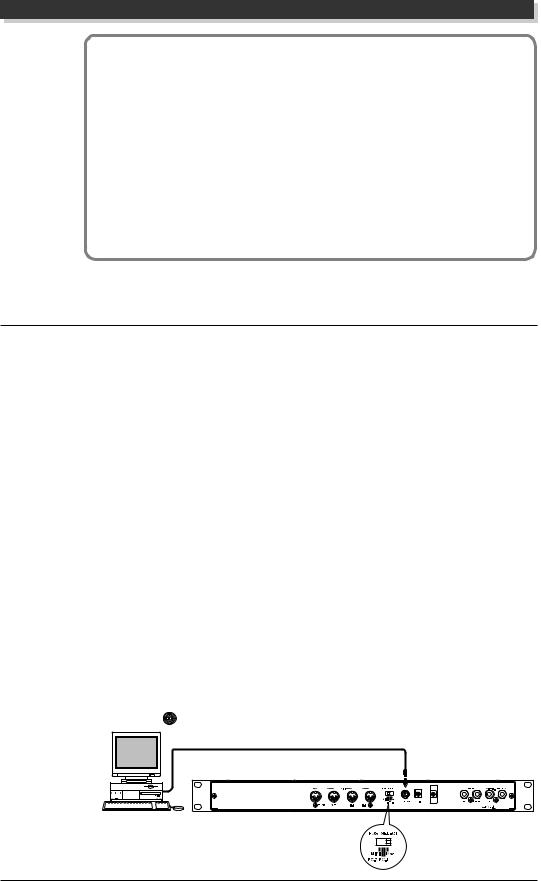
Setting U p the M U 100R in Your M usic System
O peration
1Set the HOST SELECT switch to MIDI.
2Connect the MU100R to the appropriate MIDI device.
Refer to the illustrations above. Use a standard MIDI cable (see page 92).
3Turn on the the connected device, then the MU100R.
4If you are using a computer, start up your music software, and set up the appropriate options on the software for operation with the MU100R.
Connecting Directly to a Computer
The MU100R features a built-in host computer interface, allowing you to directly connect it to your computer — eliminating the need of installing a special MIDI interface to your computer. The MU100R can be used with the following computers: Apple Macintosh and compatibles, IBM PC/AT and compatibles.
If your computer has a MIDI interface you may want to connect the MU100R to it, rather than using the host computer interface on the MU100R. (See the section “ Connecting to MIDI Devices” on page 17.)
Depending on the computer or interface used, set the HOST SELECT switch to the appropriate setting: MIDI, PC-1, PC-2 (IBM and compatibles), or Mac (Macintosh and compaibles). For information on the types of cables that can be used for connection, see the section “ MIDI/Computer Connecting Cables” on page 92.
Macintosh and Compatibles
Follow these instructions if you have an Apple Macintosh not equipped with an external MIDI interface. Connect the TO HOST terminal on the MU100R to the Modem or Printer port on the Macintosh.
Modem or
Printer Port
Macintosh
Guided Tour |
19 |
Downloaded from: http://www.usersmanualguide.com/
